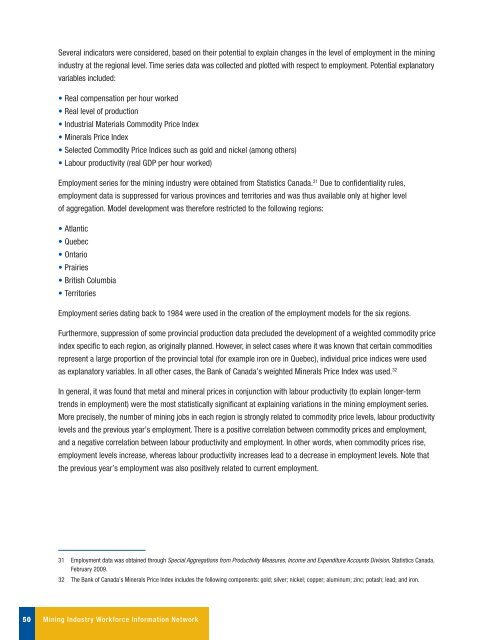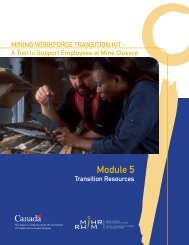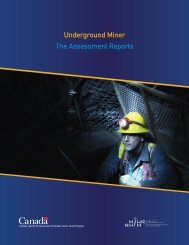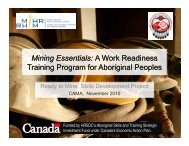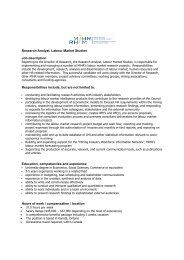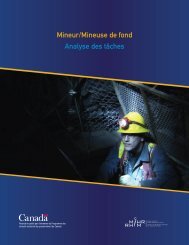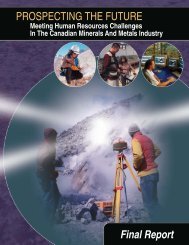Canadian Mining Industry Employment and Hiring Forecasts - MiHR
Canadian Mining Industry Employment and Hiring Forecasts - MiHR
Canadian Mining Industry Employment and Hiring Forecasts - MiHR
Create successful ePaper yourself
Turn your PDF publications into a flip-book with our unique Google optimized e-Paper software.
Several indicators were considered, based on their potential to explain changes in the level of employment in the mining<br />
industry at the regional level. Time series data was collected <strong>and</strong> plotted with respect to employment. Potential explanatory<br />
variables included:<br />
• Real compensation per hour worked<br />
• Real level of production<br />
• Industrial Materials Commodity Price Index<br />
• Minerals Price Index<br />
• Selected Commodity Price Indices such as gold <strong>and</strong> nickel (among others)<br />
• Labour productivity (real GDP per hour worked)<br />
<strong>Employment</strong> series for the mining industry were obtained from Statistics Canada. 31 Due to confidentiality rules,<br />
employment data is suppressed for various provinces <strong>and</strong> territories <strong>and</strong> was thus available only at higher level<br />
of aggregation. Model development was therefore restricted to the following regions:<br />
• Atlantic<br />
• Quebec<br />
• Ontario<br />
• Prairies<br />
• British Columbia<br />
• Territories<br />
<strong>Employment</strong> series dating back to 1984 were used in the creation of the employment models for the six regions.<br />
Furthermore, suppression of some provincial production data precluded the development of a weighted commodity price<br />
index specific to each region, as originally planned. However, in select cases where it was known that certain commodities<br />
represent a large proportion of the provincial total (for example iron ore in Quebec), individual price indices were used<br />
as explanatory variables. In all other cases, the Bank of Canada’s weighted Minerals Price Index was used. 32<br />
In general, it was found that metal <strong>and</strong> mineral prices in conjunction with labour productivity (to explain longer-term<br />
trends in employment) were the most statistically significant at explaining variations in the mining employment series.<br />
More precisely, the number of mining jobs in each region is strongly related to commodity price levels, labour productivity<br />
levels <strong>and</strong> the previous year’s employment. There is a positive correlation between commodity prices <strong>and</strong> employment,<br />
<strong>and</strong> a negative correlation between labour productivity <strong>and</strong> employment. In other words, when commodity prices rise,<br />
employment levels increase, whereas labour productivity increases lead to a decrease in employment levels. Note that<br />
the previous year’s employment was also positively related to current employment.<br />
31 <strong>Employment</strong> data was obtained through Special Aggregations from Productivity Measures, Income <strong>and</strong> Expenditure Accounts Division, Statistics Canada,<br />
February 2009.<br />
32 The Bank of Canada’s Minerals Price Index includes the following components: gold; silver; nickel; copper; aluminum; zinc; potash; lead; <strong>and</strong> iron.<br />
50 <strong>Mining</strong> <strong>Industry</strong> Workforce Information Network


